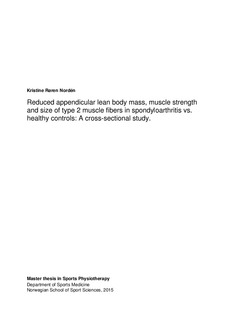Reduced appendicular lean body mass, muscle strength and size of type 2 muscle fibers in spondyloarthritis vs healthy controls: a cross-sectional study
Master thesis
Permanent lenke
http://hdl.handle.net/11250/2357526Utgivelsesdato
2015-10-21Metadata
Vis full innførselSamlinger
Sammendrag
Objective: The effect of chronic, systemic inflammation on muscle tissue is largely unknown. The purpose of this study was to investigate body composition, muscle function and muscle morphology in patients with spondyloarthritis (SpA). Methods: Ten male SpA patients (mean ±SD age 39 ±4.1 years) were compared with ten healthy controls matched for age, body mass index and self-reported level of exercise. Body composition was measured by dual energy X-ray absorptiometry. Quadriceps femoris (QF) strength was assessed by maximal isometric contractions prior to test of muscular endurance. Magnetic resonance imaging of QF was used to calculate specific muscle strength. Percutaneous needle biopsy samples were taken from m. vastus lateralis. Results: SpA patients presented with significantly lower appendicular lean body mass (LBM) (p= 0.02), but there was no difference in bone mineral density, fat mass or total LBM. Absolute and specific strength of the left QF was significantly lower in SpA patients (p= 0.01 and 0.04) with a parallel trend observed for the right leg. Biopsy samples from the SpA patients revealed significantly smaller cross-sectional area (CSA) of type 2 muscle fibers (p= 0.04), but no difference in CSA type 1 fibers. Conclusion: Results indicate that the presence of SpA disease is associated with reduced appendicular LBM, muscle strength and type 2 fiber CSA. Further research is needed to investigate whether catabolic pathways are up-regulated in SpA patients. Strength training may be an effective countermeasure against these negative effects on muscle indicated in SpA patients.
Beskrivelse
Masteroppgave - Norges idrettshøgskole, 2015
